Abstract
In the context of sharing manufacturing, a three-echelon low-carbon supply chain has been established, consisting of the leader-shared manufacturing platform, the follower surplus capacity demander, and the surplus capacity provider. Furthermore, the differential game method is used to determine the best equilibrium strategy for the perfect trajectory of product emission reduction and the ideal profit of supply chain participants in three scenarios: decentralized decision-making, centralized decision-making, and decentralized decision-making based on a two-way cost-sharing contract taking into account the long-term and dynamic nature of emission reduction issues. We compare the three scenarios by using analysis and numerical simulation. The findings show that once the contract was implemented, supply chain members’ levels of effort, product emission reduction, and supply chain system profit reached centralized decision-making levels, achieving the dual Pareto improvement of economic and environmental advantages. The conclusions achieved may be used as a theoretical framework for decision-making by players in the low-carbon supply chain, as well as a collaborative approach.
1. Introduction
The sharing economy offers the opportunity for better ways to reform and upgrade the industrial sector. Manufacturing businesses may pool resources and effectively employ the remaining manufacturing capacity by establishing a shared manufacturing platform that matches the resources of both the supply and demand sides. The shared manufacturing platform does not have its own manufacturing capacity; rather, it integrates the production capacity of multiple manufacturing enterprises, promotes the transaction of shared manufacturing capacity, and connects the service-oriented central platform of both supply and demand. Figure 1 depicts the shared manufacturing platform’s structure. Shared manufacturing will become a major element in promoting manufacturing sector transformation and development. It will concentrate on the sharing and innovation of processing and manufacturing skills, as well as the creation of a shared platform for manufacturing resources such as production equipment, special tools, and production lines. It will provide shared manufacturing services through multi-factory collaboration, effectively use the shared manufacturing platform’s traction function, and support the high-quality growth of the manufacturing sector. Therefore, manufacturing companies must focus on the sharing of surplus capacity and the development of low-carbon emission reduction products.

Figure 1.
Schematic diagram of the shared manufacturing platform.
This paper’s research subjects are divided into three categories: shared manufacturing, low-carbon emission reduction, and contract design. We conduct a literature review based on these three criteria.
In terms of shared manufacturing, Ellen [1] was the first to introduce the phrase “shared manufacturing” in 1990. Shared manufacturing has attracted much interest since its establishment. Richard et al. [2] expanded on the notion of shared manufacturing by constructing a cost model and evaluating the model’s practical and technical viability by analyzing various qualitative factors. He et al. [3] used relevant examples from the manufacturing industry to compare the strengths and weaknesses of Chinese and foreign shared manufacturing. To solve the high-degree dynamics and uncertainties associated with service operations, Yu et al. [4] presented a hybrid integrated and interoperable shared manufacturing architecture. Yu et al. [5] presented a paradigm for Blockchain-based shared manufacturing (BSM) and built a Resource Operations Blockchain (ROB). For the needs of shared manufacturing, Rozman et al. [6] created a sustainable blockchain-based shared manufacturing system. Yan et al. [7] examined the advancement of shared manufacturing platform operation management. They detailed the evaluation index system, modeling methodologies, and solution methods in a systematic manner. Li et al. [8] created a multi-stage dynamic game model in the context of sharing manufacturing that is built on two models: the commercial cloud platform and the not-for-profit sharing platform. Wang et al. [9] suggested an integrated architecture to solve the problems of inefficient resource allocation in shared manufacturing as well as resource suppliers’ unguaranteed credit. Zhang et al. [10] built a service model for production resource management in order to collect hybrid experience data from users/customers who shared resources or their analogs. Ji et al. [11] pioneered parallel-machine scheduling in shared manufacturing. They solved the problem of a fixed number of machines using a completely polynomial-time approximation format and achieved sustainable production. Wei et al. [12] explored two two-machine hybrid flow-shop issues with a fixed machining sequence to address a series of scheduling challenges in shared production with a fixed machining sequence. Xu et al. [13] investigated the online parallel machine scheduling problem in shared production with machine rental cost reduction.
In terms of low-carbon emission reduction, Ye et al. [14] developed a two-level low-carbon supply chain differential game model that considered both consumers’ low-carbon preferences and reference level impacts. Zhu et al. [15] created a three-stage game model that took into account government subsidies. Through numerical modeling, they provided the government with a reference for low-carbon supply chain support programs. Liu et al. [16] concentrated on the impact of competitiveness and customer environmental awareness on supply chain actors. Using a two-stage Stackelberg game model, they investigated the dynamic connection between supply chain actors. He et al. [17] explored the pricing and green investment strategies of oligopolistic enterprises under carbon tax legislation and concluded that green investment benefits corporate profitability. Wang et al. [18] created a two-tier supply chain comprising upstream and downstream manufacturing firms. Fu et al. [19] built a supply chain framework comprising several suppliers and manufacturers to evaluate enterprise emission reduction behavior under various strategic combinations and offered appropriate punitive methods for firms that free ride. Ghosh et al. [20] analyzed a stochastic dual-channel supply chain under consumers’ low carbon preferences and cap-and-trade regulation. Ruidas et al. [21] considered a production inventory model for green products with emission reduction technology investment and green subsidy.
In terms of contract design, Roels et al. [22] devised capacity allocation and two-way contract modeling to analyze a non-cooperative game between two enterprises with non-competing product lines. Wang et al. [23] investigated the reduction in emissions in supply chain collaboration by constructing three contract models: wholesale price contract, cost-sharing contract, and cost-sharing contract with bound wholesale price. De Giovanni [24] examined environmental collaboration using a reverse revenue-sharing contract in a closed-loop supply chain. Cao et al. [25] studied the effect of random market demand on two merchants’ price decisions under decentralized and centralized decision-making. Jiang et al. [26] constructed a differential game model for a low-carbon supply chain with a single producer and retailer and compared the wholesale, retail, and low-carbon levels of the game participants’ items under four scenarios. In analyzing three parameters of decentralized decision-making, centralized decision-making, and revenue-sharing contracts, Yang et al. [27] produced a game model of a prominent supplier and a manufacturer. Swami et al. [28] researched the subject of the differing extents of effort and cooperation between retailers and manufacturers and designed a tariff contract to coordinate the supply chain in order to address the issue of green coordination between manufacturers and retailers in a vertical supply chain. When estimating energy efficiency thresholds, Xie [29] examined the effects of decision-makers. He additionally evaluated the effects of green supply chains in vertically integrated and decentralized settings on energy efficiency levels and costs for eco-friendly products. With the aim of assisting manufacturers to generate fair contracts for individual suppliers, Ma et al. [30] advised that a manufacturer and a number of suppliers establish the same sequestration supply chain. The effects of customers’ low-carbon choices on the supply chain in the supply chain connected to emissions were assessed by Du et al. [31].
On the basis of the existing research results from the preceding three categories of literature, it is clear that the majority of the contemporary literature is a study on the current situation of shared manufacturing, whereas a little of the literature will be a shared manufacturing platform as a supply chain participant to analyze its equilibrium strategy. Furthermore, the current literature on low-carbon emission reduction issues between enterprises focuses primarily on secondary supply chain coordination issues. However, as a service provider, the shared manufacturing platform will also be concerned with its own optimum profit dilemma.
The contributions of this paper are mainly reflected in three aspects:
- (1)
- To examine long-term and dynamic low-carbon emission reduction concerns in shared manufacturing, we employ differential game approaches. The previous literature is from a specific perspective to analyze a single component of the problem; we thoroughly consider three parts of the problem: shared manufacturing, low-carbon emission reduction, and contract design.
- (2)
- We have built a three-echelon supply chain low-carbon emission reduction system, that involves the involvement and leadership of a shared manufacturing platform. Given that the proportion of low-carbon consumers and consumer willingness to pay influence market demand, a differential game model of centralized decision-making, decentralized decision-making, and decentralized decision-making based on a two-way cost-sharing contract is built, and the long-term dynamic coordination problem of low-carbon emission reduction is studied.
- (3)
- Based on the findings, we propose that if low-carbon supply chain enterprises agree ahead of time before reducing emissions, a reasonable cost sub-order ratio can not only coordinate the supply chain, but also achieve the dual Pareto improvement of environmental and economic benefits, which can provide supply chain cooperation through scientific reference.
The remainder of this paper is structured as follows. The problem description and model assumptions are introduced in Section 2. In Section 3, we build the three-echelon differential game model and suggest a solution. Section 4 provides comparative analysis. Section 5 provides numerical analysis. Finally, in Section 6, there are conclusions.
2. Problem Description and Model Assumptions
2.1. Problem Description
We consider a three-echelon low-carbon supply chain system with a surplus capacity demander D, a surplus capacity provider S, and a shared manufacturing platform P. The surplus capacity provider S publishes the capacity on the shared manufacturing platform P, which uses technology to match the capacity to the surplus capacity demander D. As a leader, the shared manufacturing platform will share a portion of the cost of providers’ and demanders’ emission reduction efforts in order to encourage them to share capacity through the shared manufacturing platform, and in order to attract additional low-carbon customers, the shared manufacturing platform will undertake advertising effort A. Furthermore, in the decentralized decision-making model based on the two-way cost-sharing contract, the provider and demander share a portion of the emission reduction costs for each other in order to accomplish dual Pareto optimization. The three-echelon supply chain abatement system is shown in Figure 2. The parameters and decision variables used in this paper are given in Table 1.
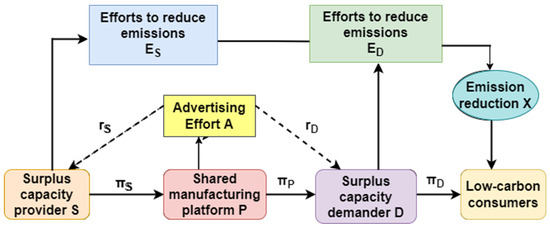
Figure 2.
Three-echelon supply chain abatement system.

Table 1.
Notations.
2.2. Model Assumptions
Assumption 1.
We assume that the supply chain’s goodwill efforts to reduce product emissions are a dynamic change process, inspired by the dynamic models developed by Jiang et al. [32] and Plambeck [33]. The level of all these efforts, as well as those of the surplus capacity provider and the surplus capacity demander, are thought to have a catalytic effect on the reduction in product emissions. The equipment used to reduce emissions will deteriorate over time. The pace of product emission reductions is normal. The product emission reduction differential equation can be inscribed as:
where denotes the marginal contribution of the surplus capacity provider and the surplus capacity demander to the reduction, respectively, indicates the natural rate of decline, and the initial decrease is X(0) = X0 ≥ 0.
Assumption 2.
Referring to the cost assumptions of [34,35], it is assumed that the costs of emission reduction and advertising efforts are convex functions of their respective efforts. That is:
Furthermore, supply chain members’ management and manufacturing expenses are assumed to be zero [36]. Among them, reflect the cost of low-carbon efforts on the surplus capacity providers and demanders in time t, as well as the cost of shared manufacturing platform advertising efforts; represent their respective cost components.
Assumption 3.
We suppose that the market has two sorts of customers: low-carbon type and ordinary type, and that the proportion of low-carbon type consumers is . According to Ye et al.’s [14] examination of consumer product choice using consumer utility theory, low-carbon customers are not only concerned with the price and performance of the product itself when purchasing the product but also with the product’s low-carbon level. Furthermore, the advertising level of the shared manufacturing platform influences customer intentions. Then, the utility of a low-carbon consumer purchasing one unit of this product is
where l represents the maximum willingness to pay for a unit of this product by a low-carbon consumer, uniformly distributed on [0,1]. The market demand for a low-carbon product can further be obtained as
where Q indicates the initial demand for the product, and indicate the impact on market demand for emission reduction and advertising efforts, respectively.
Assumption 4.
Exogenous variables are the marginal profit per unit of product of the surplus capacity provider, the shared manufacturing platform, and the surplus capacity demander , and control variables are the emission reduction efforts of the surplus capacity provider and demander ES (t) and ED (t), and advertising efforts of shared manufacturing platform operator A(t). The level of emission reduction X(t) is a status variable.
Assumption 5.
With a discount rate, policymakers aim to maximize their profits in an infinite time zone.
For simplicity of writing, similar to the Itakura et al. [37], time t is not listed below.
3. Model Formulation and Solution
3.1. Decentralized Decision-Making
The shared manufacturing platform is a service provider in the decentralized decision-making scenario (denoted by the superscript S). It is to decide on the abatement cost allowance coefficients for demanders and providers, as well as the degree of advertising effort, to entice surplus capacity providers and demanders to trade and share capacity on the platform. Thus, the decision problems for each participant are as follows:
Theorem 1.
(1) The greatest strategies for the surplus capacity provider, the shared manufacturing platform, and the surplus capacity demander under decentralized decision-making are as follows:
(2) The optimal trajectory of product reductions is as follows:
(3) The optimal profits for each surplus capacity provider, the shared manufacturing platform, and the surplus capacity demander are as follows:
where
Proof of Theorem 1.
To obtain the equilibrium strategy under decentralized decision-making, backward induction is used. The optimal value functions of the long-term profits of the surplus capacity provider, the shared manufacturing platform, and the surplus capacity demander at the time t are noted as:
satisfies the Hamilton-Jacobi-Bellman equation for any
Taking the first-order partial derivative of the right-hand side of Equations (17) and (19) concerning and making it equal to 0 gives
Substituting Equations (20) and (21) into (18) and deriving the right-hand side of it with respect to gives
Substituting Equations (22) and (23) into (19) and (20) gives
Substituting Equations (22)–(26) into Equations (17)–(19), the collation yields
Based on the structure of Equations (27)–(29), we assume that the linear expression of with respect to is as follows:
where are unknown constant. Substituting Equation (30) into (27)–(29) gives the value of in Equations (11)–(13). The proof is completed. □
3.2. Centralized Decision-Making
In the centralized decision-making (denoted by the superscript C), the supply chain members all aim to maximize the overall profit of the low carbon supply chain system, so the decision problem for the whole supply chain system is as follows:
Theorem 2.
(1) Under the centralized decision-making, the optimal strategies for the surplus capacity provider, the shared manufacturing platform, and the surplus capacity demander, respectively, are as follows:
(2) The optimal trajectory of product reductions is as follows:
(3) The optimal profit of the supply chain system is as follows:
where
3.3. Decentralized Decision-Making Based on Two-Way Cost-Sharing Contract
The centralized decision-making paradigm, which is consistent with low-carbon development, creates more low-carbon products and reaps more advantages for the supply chain. However, supply chain participants often do not relinquish their decision-making ability to put centralized decision-making into effect. We presume that a coordination contract is intended to share the cost. In such instances, members may choose to apply it willingly, allowing the supply chain system to achieve the effect of centralized decision-making even if the choice is decentralized. As a result, a two-way cost-sharing contract is intended to accomplish Pareto improvement and supply chain system coordination (denoted by the superscript *) within the restrictions of the agreement, with decentralized and centralized decision-making serving as the benchmark. We assume that the surplus capacity provider offers a cost subsidy to the demander in proportion to and that the surplus capacity demander provides a cost subsidy to the provider in proportion to . Therefore, the decision problem for each participant is
Theorem 3.
(1) The optimal strategies for the surplus capacity provider, the shared manufacturing platform, and the surplus capacity demander under decentralized decision-making based on the two-way cost-sharing contract are as follows:
(2) The optimal trajectory of product reductions is as follows:
(3) The optimal profits for each of the surplus capacity provider, the shared manufacturing platform, and the surplus capacity demander are as follows:
where
Proof of Theorem 3.
Using the backward induction, the optimal value functions of the long-term profits of the surplus capacity provider, the shared manufacturing platform, and the surplus capacity demander at time t are as follows:
satisfies the Hamilton–Jacobi–Bellman equation for any
Taking the first order partial derivative of the right-hand side of Equations (51) and (52) with respect to and making it equal to 0 gives
For the members of the game to voluntarily implement the contract, the conditions of incentive compatibility and incentive compatibility should be met, i.e.,
So we have
Substituting Equations (55) and (56) into (50)–(52) gives
Based on the structure of Equations (58)–(60), we assume that the linear expression with respect to is
where are unknown constant, substituting Equation (60) into (57)–(60) gives
The proof is completed. □
4. Comparative Analysis
Proposition 1.
The optimal abatement effort of the surplus capacity provider, the advertising effort of the shared manufacturing platform, and the optimal abatement effort of the surplus capacity demander are as follows:
Proof of Proposition 1.
From Theorems 1–3, we have
□
Proposition 2.
Under the two-way cost-sharing contract, the contract parameter has no effect on the optimal emission reduction efforts of the surplus capacity provider or the optimal emission reduction efforts of the surplus capacity demander, and the shared manufacturing platform operator will re-decide the subsidies to other game participants based on the contract parameters to avoid the impact of the two-way cost subsidy on the surplus capacity provider and demander. The extent to which emissions reduction efforts under the two-way cost-sharing contract are influenced not just by marginal profits but also by the marginal profits of other supply chain participants remains to be seen.
To reduce the influence of the two-way cost subsidy on the decisions of the surplus capacity provider and the demander, the shared manufacturing platform operator re-decides the subsidies to other game participants based on the contract specifications and decentralize its abatement effort under the judgment. Under the two-way cost-sharing contract, the degree of abatement effort is affected by its marginal profit and the marginal profit of other supply chain participants.
Proof of Proposition 2.
This follows from Theorems 1–3. □
Proposition 3.
When , the subsidies provided by the shared manufacturing platform operator to the surplus capacity provider and the demander, respectively, under decentralized decision-making are more significant than the subsidies provided to both under the two-way cost-sharing contract. Moreover, when, the shared manufacturing platform operator can bring the decisions of all participants to a centralized level without subsidizing the surplus capacity provider and the demander.
Proof of Proposition 3.
When ,
- we have .
- When ,
- we have .
That is . The proof is completed. □
Proposition 4.
In a two-way cost-sharing contract, the subsidy given by the shared manufacturing platform operator to the surplus capacity provider is inversely proportional to the help given by the surplus capacity demander for its share of the cost of abatement effort; the subsidy given by the shared manufacturing platform operator to the surplus capacity demander is inversely proportional to the helpgiven by the surplus capacity provider for its share of the cost of abatement effort.
Proof of Proposition 4.
To find the first order derivative of with respect to , we have .
The proof is completed. □
Proposition 5.
Under a two-way cost-sharing contract, the profit of each member and the total profit of the supply chain system is greater than the level of decentralized decision making, achieving Pareto improvement. That is
Proof of Proposition 5.
Similarly, it can be proved . □
Proposition 6.
Product emission reductions, the advertising efforts of shared manufacturing platform operators, and the emission reduction efforts of surplus capacity providers and demanders are all positively correlated with the proportion of low-carbon consumers .
Proof of Proposition 6.
The first-order derivative of with respect to is obtained.
Proposition 6 demonstrates how shared manufacturing platform operators may improve their advertising efforts to promote a low-carbon lifestyle in order to increase the number of low-carbon consumers. In contrast, the surplus capacity demanders and providers can indirectly enhance the degree of product emission reductions by increasing their efforts to decrease emissions. The collaboration of the game’s participants will help to establish a low-carbon emission reduction mechanism.
5. Numerical Analysis
The data relating to the surplus capacity provider and the shared manufacturing platform in each of the three game situations are investigated arithmetically in this part, using exogenous variable assignment to validate the model. We will discuss the impact of each parameter on the decision in this part. Referring to Zhu and You [38] and Xu et al. [39], the following parameter values of the simulation are set: .
5.1. Integrity Analysis
Figure 3 shows that the level of product emission reduction under decentralized decision-making is lower than the level of emission reduction under the two-way cost-sharing contract and centralized decision-making, and the level of emission reduction under centralized decision-making and the two-way cost-sharing contract is equal. Simultaneously, as time passes, the level of emission reduction gradually stabilizes, indicating that if the level of emission reduction is affected by external factors, it will be affected initially, but it will gradually stabilize over time, and the entire level of emission reduction is controllable.
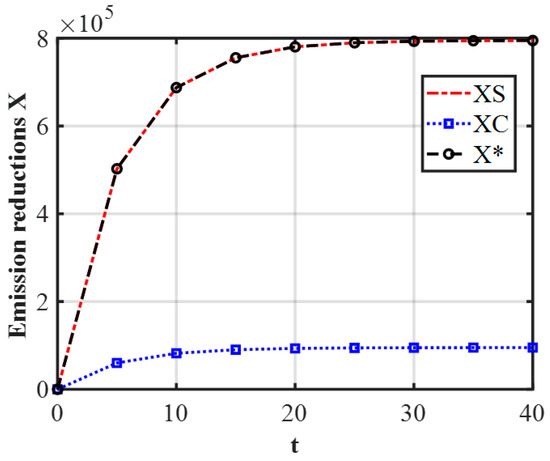
Figure 3.
Product emission reduction change curve.
As shown in Figure 4, Figure 5 and Figure 6, the total profit of the decentralized decision-making supply chain system based on the two-way cost-sharing contract is equal to the total profit of the centralized decision-making supply chain system, and it is significantly greater than the total system profit of the supply chain under decentralized decision-making, indicating that the two-way cost-sharing contract can achieve supply chain coordination and realize Pareto improvement.
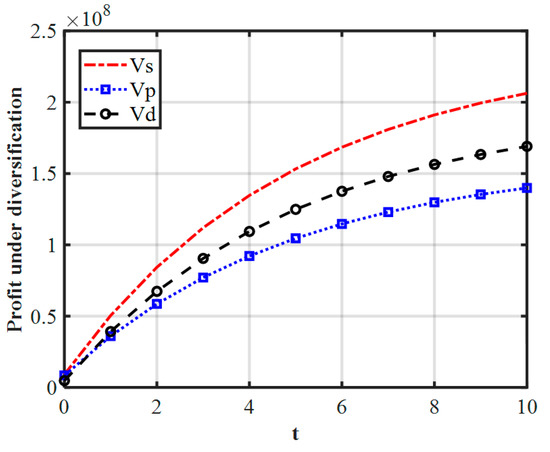
Figure 4.
Profit from decentralized decision-making.
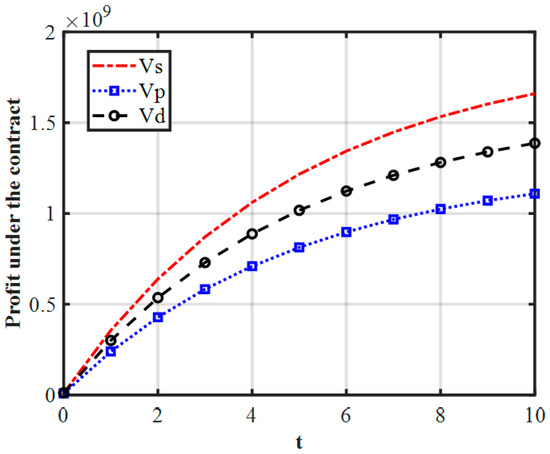
Figure 5.
Profit under the covenant.

Figure 6.
Total system profit.
5.2. Sensitivity Analysis
Figure 7, Figure 8 and Figure 9 show that as the emission reduction efforts of surplus capacity providers and surplus capacity demanders increase the impact coefficient of product emission reduction, the easier it is for surplus capacity providers and demanders to achieve the goal of low-carbon emission reduction, the stronger the cooperation intention of the entire supply chain, and thus the more obvious the effect of long-term emission reduction cooperation in the long run. The amount of emission reduction gradually increases as the impact coefficient of emission reduction on market demand increases, indicating that the greater the impact coefficient of emission reduction on market demand, the greater the consumer’s desire to buy low-carbon emission reduction products.
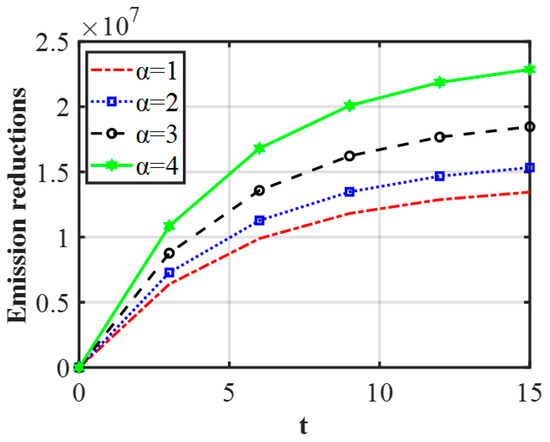
Figure 7.
The impact of on emission reductions.
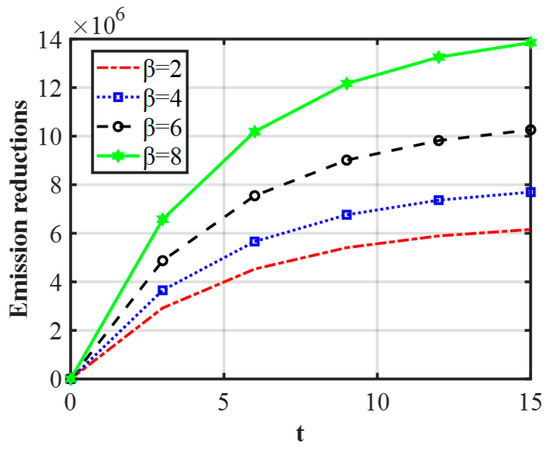
Figure 8.
The impact of on emission reductions.

Figure 9.
The impact of on emission reductions.
As seen in Figure 10, the greater the market share of low-carbon customers, the greater the decrease in product emissions. This reveals that the greater the demand for low-carbon products, the greater the possibility for enterprises to collaborate on emission reductions via a shared manufacturing platform.
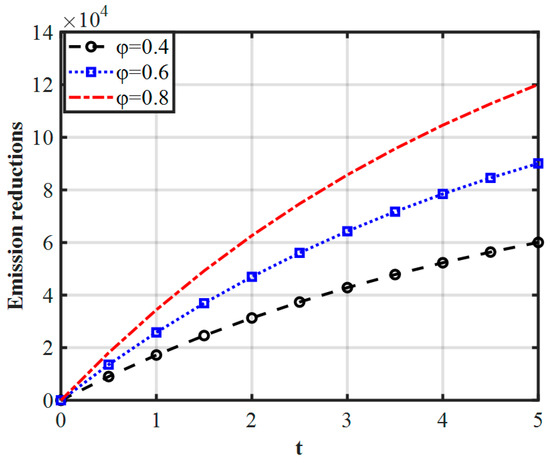
Figure 10.
The impact of on emission reductions.
As seen in Figure 11, the respective efforts of supply chain members are positively connected with the proportion of low-carbon customers, implying that the larger the number of low-carbon consumers, the greater the motivation for supply chain members to collaborate to decrease emissions. Figure 12 illustrates that when the share of low-carbon consumers grows, the overall profit of the supply chain system increases and finally stabilizes. As a result, the larger the number of low-carbon customers, the greater the level of emission reduction efforts and advertising levels of supply chain members, and, as a result, the greater the reduction in product emissions, the greater the profit of the entire supply chain system.
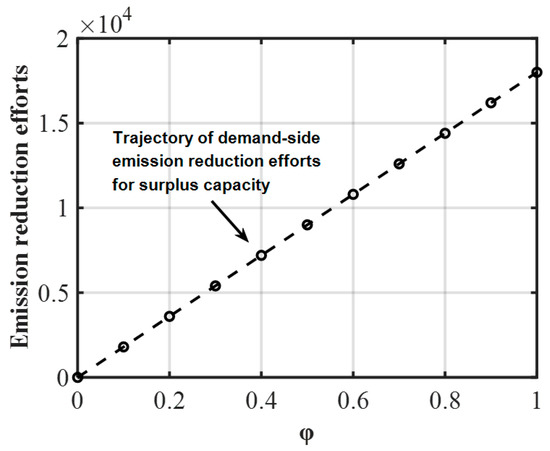
Figure 11.
The impact of on D’s reduction efforts.
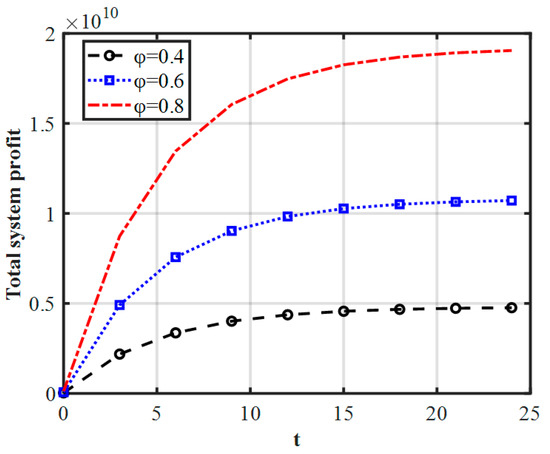
Figure 12.
The impact of on Total system profit.
As seen in Figure 13, product emission reductions grow with the marginal profit of the surplus capacity provider and demander. Both have the same amount of influence on reducing product emissions.
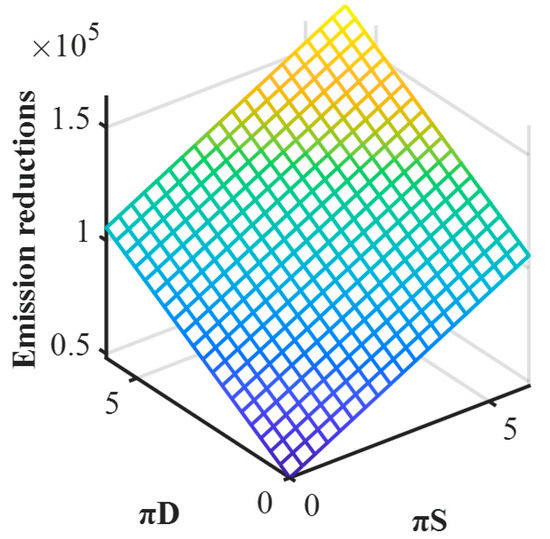
Figure 13.
The impact of on emission reductions.
Figure 14 shows that, under the two-way cost-sharing contract, the marginal profit of the surplus capacity demander will have an impact on the profit of the shared manufacturing platform operator, but the impact of the platform’s marginal profit is greater than the impact of the marginal profit of other participants.
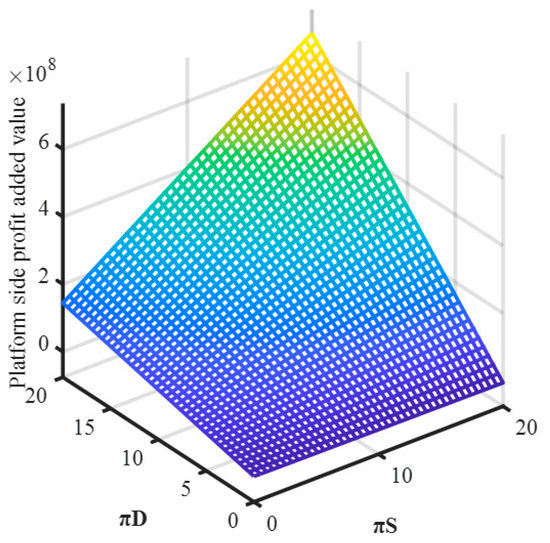
Figure 14.
The impact of on platform profits.
However, as shown in Figure 15, under the two-way cost-sharing contract, the surplus capacity provider’s profit is only affected by the marginal profit from the marginal margin, and it has nothing to do with the marginal profit of the surplus capacity demander. Similarly, as shown in Figure 16, the profit of the surplus capacity demander is only affected by the marginal profit from the marginal margin and has nothing to do with the marginal profit of the surplus capacity demander.

Figure 15.
The impact of on provider profit.
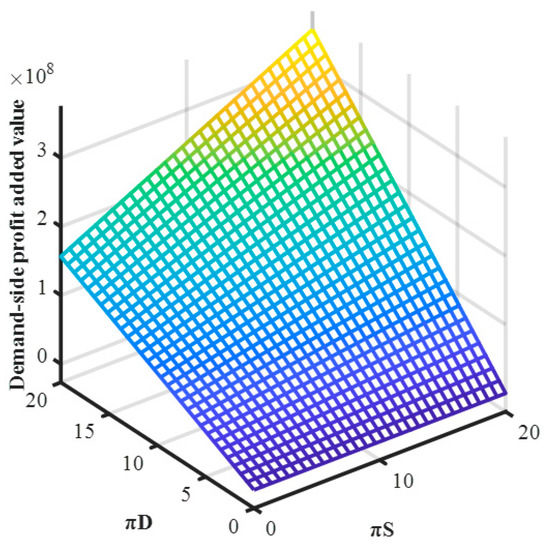
Figure 16.
The impact of on demand-side profits.
As shown in Figure 17, the rate of the natural decline in emission reductions is inversely proportional to the profits of each system member under a two-way cost-sharing contract, implying that supply chain members should either increase their level of emission reduction efforts or strive to improve their technology to reduce losses due to natural decline.
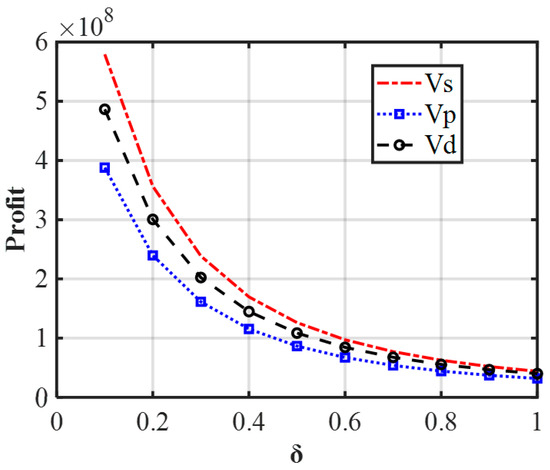
Figure 17.
The impact of on profit.
As shown in Figure 18, as the share of low-carbon consumers in market demand grows, so does the present value of each member’s profit. The bigger the number of environmentally friendly consumers in the market, the greater the supply chain members’ emission reduction efforts and advertising activities, the better the reduction in product emissions, and therefore the greater the profitability of supply chain members.
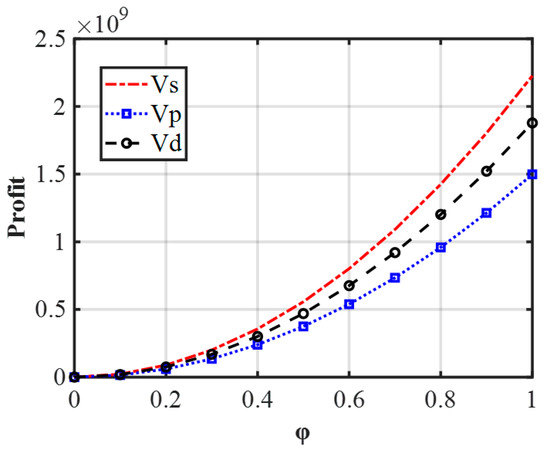
Figure 18.
The impact of on profit.
6. Conclusions and Managerial Implications
This paper compares and analyzes the optimal decision problem of each game member in a three-echelon supply chain consisting of a surplus capacity provider, a shared manufacturing platform, and a surplus capacity demander in the context of decentralized decision-making, centralized decision-making, and decentralized decision-making based on the two-way cost-sharing contract in shared manufacturing.
The research results are as follows:
- (1)
- Under decentralized decision-making, the surplus capacity providers and demanders’ optimal emission reduction efforts, the level of emission reduction, and the profit of each game member are lower than under centralized decision-making and the two-way cost-sharing contract.
- (2)
- When the surplus capacity provider and the demander split the cost of emission reduction in a predetermined proportion, the shared manufacturing platform operator may achieve the desired degree of centralized decision-making without cost subsidies for the two. As a result, the shared manufacturing platform operator is more inclined to adopt a two-way cost-sharing contract as a leader.
- (3)
- The shared manufacturing platform operator can enhance its advertising efforts to encourage more conventional customers to transition to low-carbon consumers, increasing the market’s proportion of low-carbon consumers and attaining green and high-quality economic development.
- (4)
- The introduction of the two-way cost-sharing contract increases the optimal emission reduction efforts of the surplus capacity providers and demanders, as well as the profits of supply chain members and the total profits of the system, and allows rational players to implement the contract voluntarily, thus realizing the Pareto optimum, achieving a win-win situation, and coordinating.
Through the analysis of the model results, we get some important managerial implications as follows:
- (1)
- To boost carbon emission reduction performance, maximize economic and environmental benefits, and achieve dual Pareto optimization, the capacity demanders and providers should transition as much as possible from independent operation to collaborative work with other energy-saving and emission-reduction enterprises.
- (2)
- The decentralized decision-making of the two-way cost-sharing contract encourages win-win collaboration among supply chain members, and enterprises may consider creating similar contracts as a means of eliminating low-carbon emissions.
- (3)
- Cooperation between the capacity demander and the capacity provider requires a reasonable sharing of both sides’ expenses. Businesses can employ the decentralized decision-making scenario of the two-way cost sharing contract described in this article in the real world.
The following is the research’s future work. Firstly, this study exclusively considers a three-echelon supply chain emission reduction system that comprises a shared manufacturing platform, a surplus capacity provider, and a surplus capacity demander. In actuality, however, this is typically a game with multiple players, which changes the equilibrium result. In the future, we may consider exploring multi-member game concerns. Secondly, because most rivalry has shifted from between enterprises to between supply chains, the game between supply chains will be thoroughly researched. Thirdly, the next stage of research is a real case study or data collected from the industry.
Author Contributions
P.L. and Y.C developed the methodology and drafted the manuscript; Y.C. performed the numerical simulations and experiments and wrote the original draft. All authors have read and agreed to the published version of the manuscript.
Funding
This work was supported in part by the Science Research Foundation of Educational Department of Liaoning Province under Grant WJGD2020001, in part by the Research Project on Economic and Social Development of Liaoning Province under Grant 2022lsljdwzzkt-007, in part by the Key Program of Social Science Planning Foundation of Liaoning Province under Grant L21AGL017.
Institutional Review Board Statement
Not applicable.
Informed Consent Statement
Not applicable.
Data Availability Statement
Not applicable.
Acknowledgments
We are grateful to the editor and the anonymous referees for their helpful comments and suggestions. The authors wish to acknowledge the contribution of Liaoning Key Lab of Equipment Manufacturing Engineering Management, Liaoning Research Base of Equipment Manufacturing Development, Liaoning Key Research Base of Humanities and Social Sciences: Research Center of Micro-management Theory of SUT.
Conflicts of Interest
The authors declare no conflict of interest. We declare that there are no conflicts of interests regarding the publication of this article.
References
- Ellen, B. A vision for shared manufacturing. Mech. Eng. 1990, 112, 52–55. [Google Scholar]
- Richard, E.B.; Fred, D.; Cody, J.H.; Gary, E.S.; Edward, S.; Steven, S. A group technology model to assess consolidation and reconfiguration of multiple industrial operations—A shared manufacturing solution. Int. J. Comput. Integr. Manuf. 1993, 6, 311–322. [Google Scholar]
- He, J.; Zhang, J.; Gu, X. Research on sharing manufacturing in Chinese manufacturing industry. Int. J. Adv. Manuf. Technol. 2019, 104, 463–476. [Google Scholar] [CrossRef]
- Yu, C.Y.; Xu, X.; Yu, S.; Sang, Z.Q.; Jiang, X.L. Shared manufacturing in the sharing economy: Concept, definition and service operations. Comput. Ind. Eng. 2020, 146, 106602. [Google Scholar] [CrossRef]
- Yu, C.Y.; Jiang, X.L.; Yu, S.Q.; Yang, C. Blockchain-based shared manufacturing in support of cyber physical systems: Concept, framework, and operation. Robot. Comput. Integr. Manuf. 2020, 64, 101931. [Google Scholar] [CrossRef]
- Rozman, N.; Diaci, J.; Corn, M. Scalable framework for blockchain-based shared manufacturing. Robot. Comput.-Integr. Manuf. 2021, 71, 102139. [Google Scholar] [CrossRef]
- Yan, P.Y.; Yang, L.; Che, A.D. Review of supply-demand matching and scheduling in shared manufacturing. Syst. Eng. Theory Pract. 2022, 42, 811–832. [Google Scholar]
- Li, K.; Xiao, W.; Zhu, X. Pricing strategies for sharing manufacturing model based on cloud platform. Control Decis. 2022, 37, 1056–1066. [Google Scholar]
- Wang, G.; Zhang, G.; Guo, X.; Zhang, Y. Digital twin-driven service model and optimal allocation of manufacturing resources in shared manufacturing. J. Manuf. Syst. 2021, 59, 165–179. [Google Scholar] [CrossRef]
- Zhang, G.; Chen, C.; Liu, B.; Li, X.Y.; Wang, Z.X. Hybrid sensing-based approach for the monitoring and maintenance of shared manufacturing resources. Int. J. Prod. Res. 2022, in press. [Google Scholar] [CrossRef]
- Ji, M.; Ye, X.; Qian, F.Y.; Cheng, T.C.L.; Jiang, Y.W. Parallel-machine scheduling in shared manufacturing. J. Ind. Manag. Optim. 2022, 18, 681–691. [Google Scholar] [CrossRef]
- Wei, Q.; Wu, Y. Two-machine hybrid flow-shop problems in shared manufacturing. Comput. Modeling Eng. Sci. 2022, 131, 1125–1146. [Google Scholar] [CrossRef]
- Xu, Y.; Zhi, R.; Zheng, F.; Liu, M. Competitive algorithm for scheduling of sharing machines with rental discount. J. Comb. Optim. 2022, 44, 414–434. [Google Scholar] [CrossRef]
- Ye, T.; Guan, Z.; Tao, J.; Qu, Y. Dynamic optimization and coordination about joint emission reduction in a supply chain considering consumer preference to low carbon and reference low-carbon level effect. Chin. J. Manag. Sci. 2017, 25, 52–61. [Google Scholar]
- Zhu, Q.; Dou, Y. A game model for green supply chain management based on government subsidies. J. Manag. Sci. China 2011, 14, 86–95. [Google Scholar]
- Liu, Z.L.; Anderson, T.D.; Cruz, J.M. Consumer environmental awareness and competition in two-stage supply chains. Eur. J. Oper. Res. 2012, 218, 602–613. [Google Scholar] [CrossRef]
- He, H.; Ma, C.; Wu, Z. Pricing decision with green technology input under cap-and-trade policy. Chin. J. Manag. Sci. 2016, 24, 74–84. [Google Scholar]
- Wang, Q.; Zhao, D.; He, L. Strategies selection and behavioral evolution of carbon-emission-reduction investment in supply chain firms. J. Ind. Eng. Manag. 2014, 28, 181–189. [Google Scholar]
- Fu, Q.; Xin, L.; Ma, S. Evolutionary game of carbon-emission-reduction investment in supply chains under a contract with punishment mechanism. J. Manag. Sci. China 2016, 19, 56–70. [Google Scholar]
- Ghosh, S.K.; Seikh, M.R.; Chakrabortty, M. Analyzing a stochastic dual-channel supply chain under consumers’ low carbon preferences and cap-and-trade regulation. Comput. Ind. Eng. 2020, 149, 106765. [Google Scholar] [CrossRef]
- Ruidas, S.; Seikh, M.R.; Nayak, P.K. A production inventory model for green products with emission reduction technology investment and green subsidy. Process Integr. Optim. Sustain. 2022, in press. [Google Scholar] [CrossRef]
- Roels, G.; Tang, C.S. Win-win capacity allocation contracts in coproduction and codistribution alliances. Manag. Sci. 2017, 63, 861–881. [Google Scholar] [CrossRef]
- Wang, Y.; Zhu, Q.; Xia, X. Supply chain upstream and downstream joint coordination contract game model based on consumer preference. J. Syst. Eng. 2017, 32, 188–198. [Google Scholar]
- De Giovanni, P. Environmental collaboration in a closed-loop supply chain with a reverse revenue sharing contract. Ann. Oper. Res. 2014, 220, 135–157. [Google Scholar] [CrossRef]
- Cao, X.; Wen, H. Pricing and coordination of closed-loop supply chain considering competition between retailers under stochastic demand. Oper. Res. Manag. Sci. 2015, 24, 34–39. [Google Scholar]
- Jiang, S.; Li, S. Green supply chain game models and revenue sharing contract with product green degree. Chin. J. Manag. Sci. 2015, 23, 169–176. [Google Scholar]
- Yang, S.; Wang, P. Game and optimization of a two-level low-carbon supply chain under the carbon quota policy. Control Decis. 2016, 31, 924–928. [Google Scholar]
- Swami, S.; Shah, J. Channel coordination in green supply chain management. J. Oper. Res. Soc. 2013, 64, 336–351. [Google Scholar] [CrossRef]
- Xie, G. Modeling decision processes of a green supply chain with regulation on energy saving level. Comput. Oper. Res. 2015, 54, 266–273. [Google Scholar] [CrossRef]
- Ma, X.; Ho, W.; Ji, P.; Talluri, S. Contract design with information asymmetry in a supply chain under an emissions trading mechanism. Decis. Sci. 2018, 49, 121–153. [Google Scholar] [CrossRef]
- Du, S.; Jiang, Z.; Jiao, H.; Ye, W. Game-theoretical analysis for supply chain with consumer preference to low carbon. Int. J. Prod. Res. 2015, 53, 3753–3768. [Google Scholar] [CrossRef]
- Jiang, Y.; Han, S.; Zhao, Y. Differential game analysis of dynamic carbon emission reduction strategy of three-echelon supply chain under low-carbon economy. Oper. Res. Manag. Sci. 2020, 29, 89–97. [Google Scholar]
- Plambeck, E.-L. Reducing greenhouse gas emissions through operations and supply chain management. Energy Econ. 2012, 34, S64–S74. [Google Scholar] [CrossRef]
- Xu, L.; Wang, C.X.; Zhao, J.J. Decision of dual-channel supply chain under different incentive mechanisms considering remanufacturing. Control Decis. 2017, 32, 2005–2012. [Google Scholar]
- Li, Y.; Xie, X.; Liu, Q. Study on longitudinal emission reduction investment of supply chain and government’s subsidy policy. J. Intell. Fuzzy Syst. 2018, 34, 1177–1186. [Google Scholar] [CrossRef]
- De Giovanni, P. Quality improvement vs. advertising support: Which strategy works better for a manufacturer? Eur. J. Oper. Res. 2011, 208, 119–130. [Google Scholar] [CrossRef]
- Itakura, N.; Kinbara, Y.; Fuwa, T.; Sakamoto, K. Discrimination of forearm’s motions by surface EMG signals using neural network. Appl. Hum. Sci. 1996, 15, 287–294. [Google Scholar] [CrossRef][Green Version]
- Zhu, G.; You, D. Ecological R&D strategy and coordination mechanism in the green supply chain based on differential games. Oper. Res. Manag. Sci. 2017, 26, 62–69. [Google Scholar]
- Xu, C.; Zhao, D.Z.; Yuan, B.Y.; He, L.F. Differential game model on joint carbon emission reduction and low-carbon promotion in supply chains. J. Manag. Sci. China 2016, 19, 53–65. [Google Scholar]
Publisher’s Note: MDPI stays neutral with regard to jurisdictional claims in published maps and institutional affiliations. |
© 2022 by the authors. Licensee MDPI, Basel, Switzerland. This article is an open access article distributed under the terms and conditions of the Creative Commons Attribution (CC BY) license (https://creativecommons.org/licenses/by/4.0/).